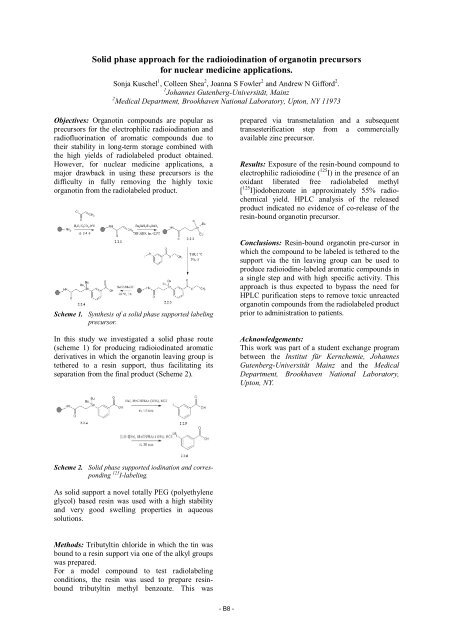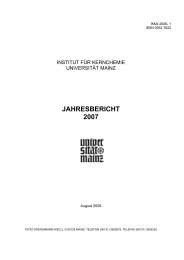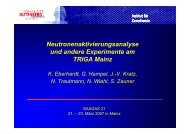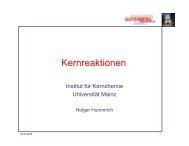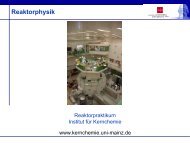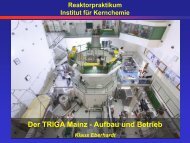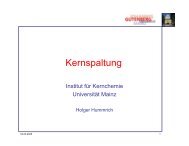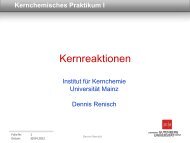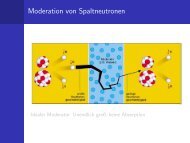institut für kernchemie universität mainz jahresbericht 2009
institut für kernchemie universität mainz jahresbericht 2009
institut für kernchemie universität mainz jahresbericht 2009
You also want an ePaper? Increase the reach of your titles
YUMPU automatically turns print PDFs into web optimized ePapers that Google loves.
Solid phase approach for the radioiodination of organotin precursors<br />
for nuclear medicine applications.<br />
Sonja Kuschel 1 , Colleen Shea 2 , Joanna S Fowler 2 and Andrew N Gifford 2 .<br />
1 Johannes Gutenberg-Universität, Mainz<br />
2 Medical Department, Brookhaven National Laboratory, Upton, NY 11973<br />
Objectives: Organotin compounds are popular as<br />
precursors for the electrophilic radioiodination and<br />
radiofluorination of aromatic compounds due to<br />
their stability in long-term storage combined with<br />
the high yields of radiolabeled product obtained.<br />
However, for nuclear medicine applications, a<br />
major drawback in using these precursors is the<br />
difficulty in fully removing the highly toxic<br />
organotin from the radiolabeled product.<br />
Scheme 1. Synthesis of a solid phase supported labeling<br />
precursor.<br />
In this study we investigated a solid phase route<br />
(scheme 1) for producing radioiodinated aromatic<br />
derivatives in which the organotin leaving group is<br />
tethered to a resin support, thus facilitating its<br />
separation from the final product (Scheme 2).<br />
Scheme 2. Solid phase supported iodination and corresponding<br />
125 I-labeling.<br />
As solid support a novel totally PEG (polyethylene<br />
glycol) based resin was used with a high stability<br />
and very good swelling properties in aqueous<br />
solutions.<br />
Methods: Tributyltin chloride in which the tin was<br />
bound to a resin support via one of the alkyl groups<br />
was prepared.<br />
For a model compound to test radiolabeling<br />
conditions, the resin was used to prepare resinbound<br />
tributyltin methyl benzoate. This was<br />
- B8 -<br />
prepared via transmetalation and a subsequent<br />
transesterification step from a commercially<br />
available zinc precursor.<br />
Results: Exposure of the resin-bound compound to<br />
electrophilic radioiodine ( 125 I) in the presence of an<br />
oxidant liberated free radiolabeled methyl<br />
[ 125 I]iodobenzoate in approximately 55% radiochemical<br />
yield. HPLC analysis of the released<br />
product indicated no evidence of co-release of the<br />
resin-bound organotin precursor.<br />
Conclusions: Resin-bound organotin pre-cursor in<br />
which the compound to be labeled is tethered to the<br />
support via the tin leaving group can be used to<br />
produce radioiodine-labeled aromatic compounds in<br />
a single step and with high specific activity. This<br />
approach is thus expected to bypass the need for<br />
HPLC purification steps to remove toxic unreacted<br />
organotin compounds from the radiolabeled product<br />
prior to administration to patients.<br />
Acknowledgements:<br />
This work was part of a student exchange program<br />
between the Institut <strong>für</strong> Kernchemie, Johannes<br />
Gutenberg-Universität Mainz and the Medical<br />
Department, Brookhaven National Laboratory,<br />
Upton, NY.


